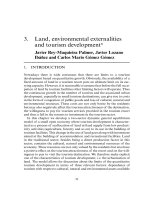THE ECONOMICS OF MONEY,BANKING, AND FINANCIAL MARKETS 465
Bạn đang xem bản rút gọn của tài liệu. Xem và tải ngay bản đầy đủ của tài liệu tại đây (48.83 KB, 1 trang )
CHAPTER 17
Tools of Monetary Policy 433
tions. For example, the LVTS is used to settle over 20 000 payments daily, with a value
of over $185 billion. This information eliminates most of the uncertainty from settlement balance prediction the largest reason for financial institutions not being able
to hit their target settlement balances with the Bank of Canada in the pre-LVTS system. Settlement of payment obligations among LVTS participants takes place, at the
end of each banking day, through the transfer of funds in their settlement accounts
at the Bank of Canada. The LVTS uses multilateral netting, in which only the net
credit or debit position of each participant vis- -vis all other participants is calculated
for settlement, thereby reducing the need for a large amount of settlement balances.
Non-LVTS
(ACSS)
Transactions
Although the LVTS eliminates the uncertainty from daily wholesale settlement balances prediction, there is still a residual stochastic element in settlement balances
from non-LVTS paper-based payments items (such as paper cheques, travellers
cheques, gift certificates, and money orders), and electronic payments items (such
as pre-authorized debits and fund transfers, direct deposit items, and debit card
transactions). Those items are cleared through the Automated Clearing Settlement
System (ACSS), an electronic payments system also operated by the Canadian
Payments Association, but without the vigorous risk controls of the LVTS. The
ACSS aggregates interbank payments and calculates the net amounts to be transferred from and to each participant s settlement account with the Bank of Canada.
The Bank completes the settlement the next day (at midday) through the LVTS.
Regarding the smaller value of ACSS settlements, direct clearers with positive
clearing balances in the ACSS (that is, with net credit positions) receive an interest
payment (calculated daily by the Canadian Payments Association, at the Bank of
Canada s target overnight interest rate) to cover their cost of crediting their customers
accounts on the business day before receiving funds in settlement. On the other hand,
direct clearers with net debit positions in the ACSS make payments (also at the Bank s
target overnight interest rate) to offset their benefit of debiting the accounts of their
customers on the day before paying funds in settlement. Interest compensation is
included in the clearing balances settled at the Bank of Canada using LVTS funds.3
The Bank of
Canada s
Policy Rate
The overnight market in Canada is the key market for finance and monetary policy. This market is very liquid, with a broad range of participants, the most active
of which are deposit-taking institutions and their investment dealer affiliates.4 The
interest rate at which participants borrow and lend overnight funds to each other
in the money market is called the overnight interest rate. This rate is the
shortest-term rate available and forms the base of any term structure of interest
rates relation.
The Bank of Canada signals its monetary policy stance by announcing a target
for the overnight interest rate (the overnight interest rate is known as the
reference rate). The target for the overnight rate, known as the policy rate, is
the main tool the Bank uses to conduct monetary policy. This rate refers to collateralized, market-based overnight transactions. The implementation of the stance
of monetary policy is more successful when the reference rate is closer to the
3
There are eleven ACSS direct clearers in addition to the Bank of Canada the Big Six, Alberta Treasury
Branches, La Caisse centrale Desjardins du Qu bec, Credit Union Central of Canada, HSBC Bank
Canada, and the Laurentian Bank of Canada. Direct clearers maintain a settlement account at the Bank
of Canada and participate directly in the ACSS.
4
See Eugene Lundrigan and Sari Toll, The Overnight Market in Canada, Bank of Canada Review
(Winter 1997 1998): 27 42, for details regarding the evolution of the overnight market.









